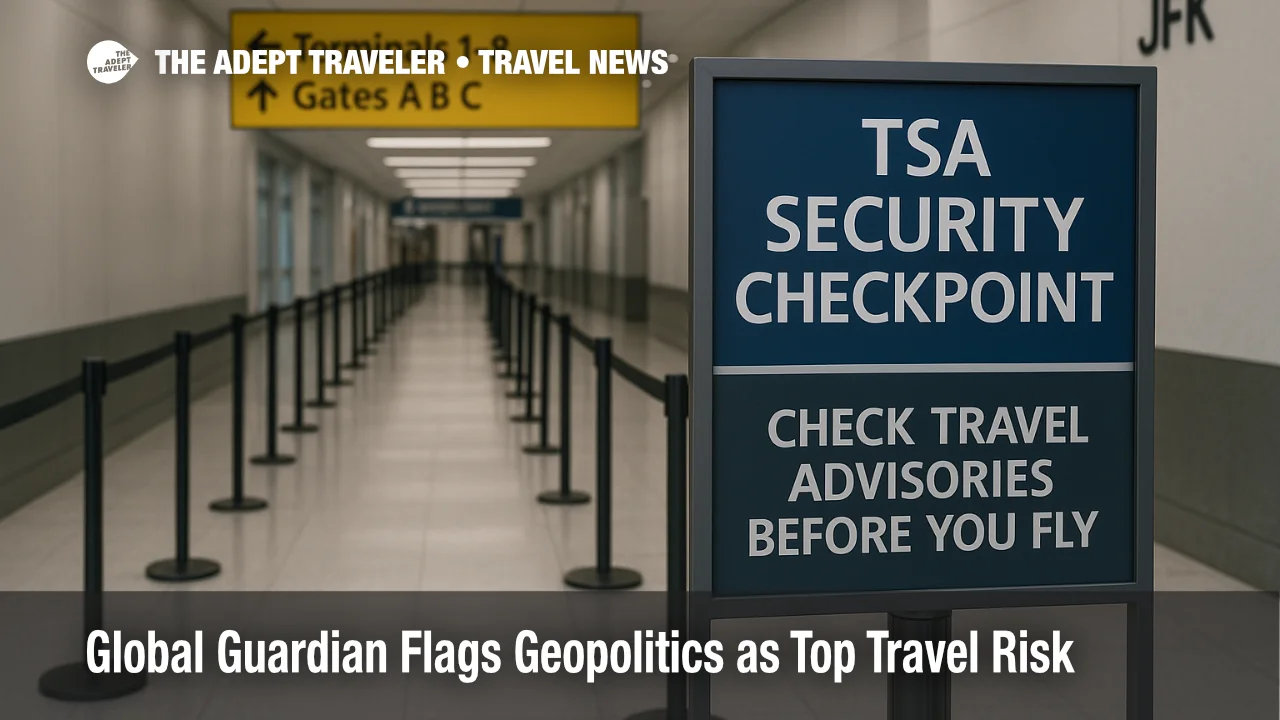Global Guardian Flags Geopolitics as Top Travel Risk

Key points
- Global Guardian's 2026 Risk Map elevates geopolitics as the top travel safety driver
- New Terror Index rates countries from Low to Extreme and tracks trajectory
- U.S. tariffs on India and the prolonged war in Ukraine are reshaping regional risk profiles
- Travelers should add political stability and exit planning to standard trip prep
Impact
- Who Is Affected
- U.S. travelers, corporate travel programs, study abroad, and leisure trips to politically sensitive regions
- What Changed
- Political stability and terrorism trajectory are now codified alongside crime, health, disasters, and infrastructure
- Where To Be Cautious
- Eastern Europe bordering Russia and select South Asia corridors affected by trade, energy, and diplomatic tensions
- What To Do
- Check country risk ratings before booking, register itineraries, rehearse emergency contacts, and build route or date flexibility
- When
- Applies to 2026 planning cycles with reassessments after major political or regulatory moves
Global Guardian's 2026 Global Risk Map places geopolitics at the center of traveler safety, arguing that political stability and geoeconomic shifts will shape routes, insurance rules, and duty-of-care decisions in the coming year. Alongside its country safety ratings, the firm introduces a Terror Index that grades both the current propensity for terrorism and its near-term trajectory. For U.S. travelers, the takeaway is clear, vet destinations through a political lens, then pre-plan contingencies before tickets are bought.
Global Guardian's 2026 view
The Risk Map aggregates indicators including crime, health, natural hazards, infrastructure, political stability, civil unrest, and terrorism. New for 2026, the Terror Index aims to help travel managers and individuals weigh not only today's risk, but where the risk line is pointing. Global Guardian's leadership has been increasingly blunt about the shift, saying that threats once considered edge cases now routinely touch executive and leisure itineraries. The company frames this as a structural change in how trips are planned, insured, and supported.
What is driving the change
Two live factors illustrate how politics now moves traveler risk. First, the long war in Ukraine continues to stress border states in Eastern Europe, which changes the calculus for overland segments, rail detours, and airspace workarounds. Second, U.S. trade policy, notably sharply higher tariffs on Indian imports, has introduced a new friction point between two large democracies. Analysts warn that such moves can spill over into operations, from visa and customs frictions to protest risk in business districts. None of this makes travel impossible, but it does raise the bar for preparation and flexibility.
How to adapt plans
For leisure and business travelers alike, make political stability a first-order filter, not a back-page appendix. Before booking, check the latest country risk rating and Terror Index trend, then sketch an exit plan, alternate routings, and a communication tree. If your employer or school offers a traveler tracking or medical and security assistance program, enroll and verify that your profile, devices, and emergency contacts are current. When the itinerary touches border regions, energy chokepoints, or cities prone to demonstrations, add buffer time, carry essential medications in cabin baggage, and favor refundable fares or hotel rates that allow changes without penalty.
Background, how these tools work
Risk maps do not predict events, they standardize how different hazards are compared. A composite "country risk" score blends multiple inputs, then the Terror Index overlays the likelihood and direction of terrorism threats. For trip planning, the practical use is triage. If the composite or the terrorism trajectory rises from Moderate to High, travelers can shift dates, re-route through hubs with stronger consular presence, or add a local fixer and secure transport for critical meetings. Corporate travel teams layer these data with internal rules, such as restricting night arrivals, requiring pre-trip briefings, or mandating daily check-ins during elevated periods.
Final thoughts
Global Guardian's 2026 Risk Map underscores a step-change, geopolitics and geoeconomics now sit alongside weather and health as core travel factors. Treat political stability and terrorism trajectory as booking inputs, not afterthoughts, and build itineraries that can bend without breaking.
